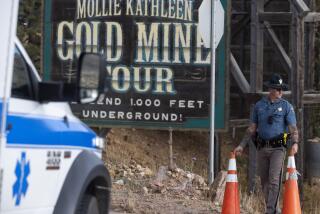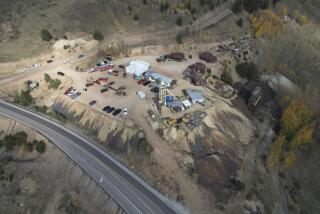Old Elevators Blamed in Children’s Deaths
- Share via
BETHEL, Maine — The 8-year-old boy’s life came to an end with the push of an elevator button.
While on vacation with his family last year, Tucker Smith stepped into the space between the outer swinging door and inner collapsible gate of a 1929 elevator at the Bethel Inn and Country Club. The outer door closed behind the 60-pound child, trapping him in a 7-inch-deep space between, just as the elevator was called up.
When it reached the second floor, the elevator shuddered to a stop. The boy was crushed between the car and the second-floor landing. He was dead of massive head trauma.
Tucker’s death sounds like a freak, unavoidable accident. It was neither. At least nine children have been killed -- four in the last four years alone -- after getting trapped between doors of old-style, swinging-door elevators, an Associated Press analysis has found.
Experts say the number of children crushed or suffocated on these elevators may be higher. The industry has known for decades that the elevator design, popular before the 1950s, is potentially deadly. Nonetheless, simple safety modifications recommended more than 15 years ago by engineers who set industry standards have not been written into regulatory laws in most states. Even where they have, enforcement is often lax.
Nobody knows for sure how many swinging-door elevators there are in the United States, but people in the industry say thousands of them continue to carry children and adults in apartment houses, hotels and other buildings.
“The fact that there is an easy, simple solution to make them safe, that’s the part that’s so troubling to me,” said Judith Rodner, a New Jersey lawyer who represented the family of Shakarr Burwell, 9, who was killed in a Newark, N.J., elevator in 1986.
The danger can be eliminated by installing a “space guard,” a metal box-like piece that bolts onto an elevator’s outer door to fill up the space between the two doors so that people can’t get trapped.
“We’re not talking about hundreds of thousands of dollars to make an elevator safe. We’re talking about hundreds of dollars” per door, Rodner said. “How do you equate that with a child’s life?”
Swinging-door elevators represent a small fraction of the 600,000-plus elevators nationwide, which carry 120 billion passengers annually, according to the Elevator Escalator Safety Foundation.
One of these old models was in the Bethel Inn, a two-story clapboard inn in western Maine where Jeffrey and Mary Smith of Bel Air, Md., brought their three children on vacation.
On Aug. 23, 2001, Tucker and his twin sister, Ellie, headed from their second-floor room to have breakfast in the ground-floor dining room with their father. Jeffrey Smith, an airline pilot, handed the room key to his wife as the children made their way down the hallway.
The father slowed in the hallway for two hotel employees in front of him as Tucker and Ellie scooted downstairs with the idea that they’d ride the elevator back upstairs to meet their dad and give him a ride.
Tucker stepped into the space between the two doors. Upstairs, a maid pushed the elevator button to summon it, and Tucker went with it, trapped on the outer ledge.
Ellie could see through the small window in the elevator door as her brother’s body disappeared as the elevator moved upward. The state medical examiner’s report includes gruesome details of how the boy was dragged up as the gap narrowed.
When the door was pried open, Tucker’s parents and sisters witnessed the results, said Terry Garmey, an attorney who represents the family. Jeffrey Smith stepped into the elevator and cradled his dead son’s bloodied head. The boy’s sisters ran shrieking down the hotel stairs.
“When the family learned Tucker wasn’t the first child who died like this, it became very important to them that he would be the last,” Garmey said.
The Smiths declined to be interviewed for this story, but Mary Smith, in a letter to the Associated Press, wrote: “We have done our best to forget the horrific scenes, but it is impossible. It is something that I do not wish any other family to endure.... We have promised our two daughters that we will do all we can to prevent similar accidents; we feel that we have a moral obligation to see that this lethal hazard is eliminated.”
The Smiths are suing the hotel, the company that maintained the elevator, and Otis Elevator Co. to draw attention to the problem, Garmey said. Lawyers for Otis Elevator, the Bethel Inn and Pine State Elevator, the company that serviced and inspected the elevator, declined to comment on the lawsuit’s allegations.
Otis manufactured the elevator and installed it in the Bethel Inn in 1929. The lawsuit contends that the company concealed the history of injuries and fatalities on swinging-door elevators and didn’t adequately warn the public.
Maine inspectors determined that the Bethel Inn’s elevator had 18 deficiencies, such as failure to perform a five-year safety test and install an alarm. The fatal flaw was the excessive space between the two doors -- Maine law allows only 4 inches -- that permitted Tucker to be trapped. “Had the elevator had only a 4-inch gap, instead of 7 inches, the door would not have been able to close on a child.”
According to an AP examination of court documents and government records, as well as interviews with lawyers and elevator experts, the same type of elevator car has been involved in at least nine fatalities since 1976 -- all children.
Hubert Hayes, an elevator consultant in New York, believes that the death count is actually higher --”many more than 10”-- but the exact number is unknown because nobody tracks such information.
There is no federal oversight of elevators or a national clearinghouse of information about them. The U.S. Consumer Product Safety Commission tracks elevator and escalator injury and death statistics, but does not have detailed reports of the incidents.
Most cases of swinging-door deaths, Hayes said, receive little publicity and are settled out of court.
Rodner said most of the deaths have not generated much public interest because they have occurred in poor, urban high-rises.
Elevator companies have known since the 1930s of the potential dangers of the elevator cars.
A former director of product safety for Otis Elevator testified that the potential hazards of the elevator design were known as early as 1931, according to a court deposition in 1993.
“For more than 70 years, Otis Elevator Company has repeatedly advised customers about the problem posed by the excessive space” between the elevator doors, the company said in a statement.
The American Society for Mechanical Engineers, which writes elevator standards, recommended in its 1955 codes for new passenger elevators that the gap between the doors should not exceed 4 inches on swinging-door models.
But the engineers group didn’t address older elevators until 1986, when it issued a new set of standards recommending that existing swinging-door elevators be equipped with space guards.
Otis Elevator has repeatedly tried to inform elevator owners and inspectors of the dangers, officials said. Most recently, Otis mailed 44,500 letters in 1995, warning elevator owners that serious injury or death “is likely to result” if somebody gets trapped between the two doors and the elevator is called to another floor. The letter advised elevator owners to install the space guards.
Experts say there’s plenty of blame to go around for the problem’s still existing: It is shared by inspectors, government regulators, elevator manufacturers and owners.
Elevator safety regulations vary greatly among states, cities and counties. There is also a mishmash of elevator inspection systems --public and private --in the various jurisdictions.
John Weldin of Weldin Engineering in Bergenfield, N.J., who has been retained in several court cases involving accidents on swinging-door elevators, said most places have not adopted the engineering society standards as law.
“If states and cities would adopt the [most recent] code, you wouldn’t have the condition you’re talking about,” Weldin said.
“The reason the latest elevator standards have not been adopted in most places is because of the financial burden they would place on elevator owners,” said Richard Atkinson, executive director of the National Assn. of Elevator Safety Authorities International, based in Arizona. And because the latest standards have not been adopted, there are thousands of elevators that are perfectly legal because they complied with the laws when installed, he said.
While declining to comment about the Bethel Inn death, Otis Elevator spokeswoman Tizz Weber said the company’s No. 1 priority is and always has been safety.
“Otis has lobbied for code changes, urged states to adopt the codes into law, and informed elevator owners of the problem -- and how to solve it,” she said.
In 1995, the company estimated that a space guard would cost $200 to $300 in materials and one “team-hour” of labor for each landing. Under those guidelines, the cost of space guards for a two-story building, such as the Bethel Inn, would be $400 to $600 plus labor. For a 20-story building, it would cost $4,000 to $6,000 plus labor.
Hayes, the elevator consultant, said manufacturers should take extra steps to address the problem. If an automobile company manufactures a model that has safety problems, it can be required to recall cars for repairs, he said. “If somebody knows there is a potentially dangerous situation, they have an obligation to take care of it.”
Otis’ Weber said building owners also have a responsibility to update their properties -- whether it be with fire alarms, sprinklers or elevators. How long, she asked, should manufacturers be responsible for their products?
“Take a 1963 Nova; they didn’t have air bags,” Weber said. “Should GM now be responsible for putting air bags in all those cars?”
Enforcement is another issue. Maine is one of the places that adopted the latest engineering society guidelines back in 1998. Nonetheless, three years later, after the Bethel Inn accident, state inspectors shut down 74 elevators in violation of the space requirement, said Kristine Ossenfort of the Department of Professional and Financial Regulation. She said she could not explain why so many elevators were operating illegally.
At the Bethel Inn, the elevator has been boarded over.
More to Read
Sign up for Essential California
The most important California stories and recommendations in your inbox every morning.
You may occasionally receive promotional content from the Los Angeles Times.













